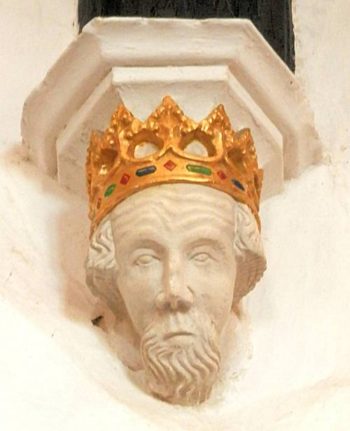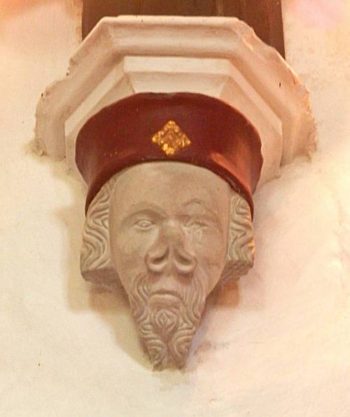Penn Church is like a history book. It may tell us, for instance, what side our predecessors took during the Wars of the Roses in the 15th century, when the houses of York and Lancaster were rivals for the throne after the death of Henry V in 1422. The stone corbels which support the fine timbered nave roof, are our source of information. They can be dated by the roof itself to the early 15th century, and so belong firmly in the period of Lancastrian domination under Henrys IV and V.

Some years ago, I discussed the corbels with Dr Clive Rouse, a national expert in medieval church art, who was responsible for their repainting in 1953. He identified two of them as representing kings. The one with the crown and the lined forehead, he suggested, was Edward III (1327-77) and was a fine piece of portrait sculpture not just a random conventional view of a king. It is indeed not unlike his tomb effigy in Westminster Abbey, although that has a longer beard. He was a famous warrior king, but Penn had particular reason to honour him as the patron of their hugely successful floor tile industry.
 The neighbouring figure, wearing a red Cap of Estate, is shown with a grotesquely enlarged and deformed nose and Dr Rouse suggested that this was a caricature of Richard 11 (1377-99) and a demonstration by Penn of their support for his deposition by Henry of Lancaster who faced a constant undercurrent of opposition and passed statutes declaring it high treason to even spread the rumour that Richard was alive. Rouse observed that caricatures of this kind were quite common and that there was quite a bit of fun about in medieval churches. For instance, bishops and kings were often shown in religious paintings amongst the lost souls en route for Purgatory.
The neighbouring figure, wearing a red Cap of Estate, is shown with a grotesquely enlarged and deformed nose and Dr Rouse suggested that this was a caricature of Richard 11 (1377-99) and a demonstration by Penn of their support for his deposition by Henry of Lancaster who faced a constant undercurrent of opposition and passed statutes declaring it high treason to even spread the rumour that Richard was alive. Rouse observed that caricatures of this kind were quite common and that there was quite a bit of fun about in medieval churches. For instance, bishops and kings were often shown in religious paintings amongst the lost souls en route for Purgatory.
My own investigations indicate that whilst the Cap of Estate was a sign of high rank, it was not, by this time, restricted to a king, but formed part of the insignia of a duke and lesser nobles and therefore could have been used on the corbel as a signal to say ‘here is a duke, but not a king’. The forehead is unlined, in contrast to its neighbour, as we would expect since Richard was only 33 when he died. However, the long split beard of the corbel does not match either of the two images of Richard in Westminster Abbey – his panel portrait, c.1395, shows him with an ordinary short beard, whereas his tomb-effigy of much the same date has it forked in two small points. The corbel’s forked beard is typical of Henry IV’s period (1399-1413), the most likely date of the corbel, but seems rather longer than the fashion. Henry V was clean shaven. Styles were clearly changing rapidly and the sculptor may have used the contemporary fashion out of ignorance, or it may be that he thought it politic not to be too specific.
The precise significance of the grotesque nose eludes me. A slit or amputated nose was a typical medieval punishment and it may refer to the charge of perjury levelled at Richard 11, who was accused of breaking his coronation oath or perhaps to lingering resentment following the Peasants’ Revolt of 1381.
There are uncertainties, but Dr Rouse’s proposal is supported by the knowledge that the Dukes of Lancaster were by this time the overlords of Penn manor in the feudal chain and that a John Penne was one of a dozen gentry and priests pardoned by the Yorkist Edward IV for taking part in a Lancastrian revolt in 1470. I would be very interested if anyone has any ideas to contribute to the debate.
© Miles Green, August 2006
